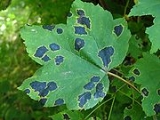
Rhytisma acerinum
Encyclopedia
Rhytisma acerinum is a plant pathogen. It commonly affects sycamores and maples
in late summer and autumn. The common name of this disease is tar spot. This disease does not usually have an adverse effect on the trees' long-term health. The disease is an Ascomycete that locally infects the leaves of trees. It is a biotrophic parasite. This disease is cosmetic and is therefore usually only controlled with sanitation methods.
The animorph of Tar Spot is Melasmia acerina. In late summer, conidiophores are formed in the mass of fugal tissue called the stroma. This stroma is in the black lesions on the infected leaves. The conidiophores form non-infectious conidia that are released both in conditions of wetness and drought. The most favorable condition is when there is an extended period of moisture such as fog or rain, keeping the leaves from drying out. During this time, a milky substance is excreted from the conidiophores containing conidia for wet dispersal. In times of drought, the conidia stick together as one unit and form yellowish tendrils. Because the conidia are not infectious, this stage is not seen as often as the teleomorph and it is not certain why the spores are produced.
Maples
-People:* Chauncy Maples , British Anglican missionary and bishop in Africa* John Maples, Baron Maples , British politician* Marla Maples , American actress, former wife of Donald Trump...
in late summer and autumn. The common name of this disease is tar spot. This disease does not usually have an adverse effect on the trees' long-term health. The disease is an Ascomycete that locally infects the leaves of trees. It is a biotrophic parasite. This disease is cosmetic and is therefore usually only controlled with sanitation methods.
Symptoms
In late spring, yellow chlorotic spots appear on leaves, these develop brown-black lesions, retaining the yellow border. As the summer continues, the lesions grow forming a spot that looks like tar on the leaf by the end of summer. The spot can grow up to 1.5 inches in diameter. This can cause early dropping of leaves but is mostly of cosmetic importance.Affected species
Rhytisma acerinum can occur in many tree species the most common being in the genus Acer. Specific varieties affected most commonly by the disease are the Norway Maple, the Silver Maple and Sycamore trees.Disease cycle
The teleomorph of Tar Spot is Rhytisma acerinum. In the spring, needle-shaped ascospores are released from overwintered apothecia in fallen leaf debris from the previous season. These spores are disseminated by the wind and have a sticky coat to attach to newly-bloomed healthy leaves. Once on the leaves, the spores germinate and penetrate through the stoma. This causes the chlorosis of the leaves in localized yellow spots. As the season continues into summer, the apothecia begin to form, making brown-black lesions that resemble spots of tar on the leaf.They retain their yellow border from the initial chlorosis. When the leaves fall, the apothecia survive in the debris over winter, releasing spores when the temperature is warm again. The infection of Tar Spot is localized to the chlorotic areas on the leaves and is mostly a cosmetic issue, rather than a systemic one.The animorph of Tar Spot is Melasmia acerina. In late summer, conidiophores are formed in the mass of fugal tissue called the stroma. This stroma is in the black lesions on the infected leaves. The conidiophores form non-infectious conidia that are released both in conditions of wetness and drought. The most favorable condition is when there is an extended period of moisture such as fog or rain, keeping the leaves from drying out. During this time, a milky substance is excreted from the conidiophores containing conidia for wet dispersal. In times of drought, the conidia stick together as one unit and form yellowish tendrils. Because the conidia are not infectious, this stage is not seen as often as the teleomorph and it is not certain why the spores are produced.

